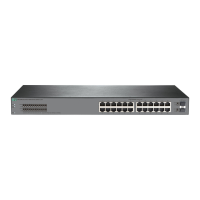205
Configuring the DHCPv6 client
About the DHCPv6 client
With DHCPv6 client configured, an interface can obtain configuration parameters from the DHCPv6
server.
A DHCPv6 client can use DHCPv6 to complete the following functions:
• Obtain an IPv6 address, an IPv6 prefix, or both, and obtain other configuration parameters. If
DHCPv6 server is enabled on the device, the client can automatically save the obtained
parameters to a DHCPv6 option group. With the obtained IPv6 prefix, the client can generate its
global unicast address.
• Support stateless DHCPv6 to obtain configuration parameters except IPv6 address and IPv6
prefix. The client obtains an IPv6 address through stateless IPv6 address autoconfiguration. If
the client receives an RA message with the M flag set to 0 and the O flag set to 1 during address
acquisition, stateless DHCPv6 starts.
Restrictions and guidelines: DHCPv6 client
configuration
Do not configure the DHCPv6 client on the same interface as the DHCPv6 server or the DHCPv6
relay agent.
DHCPv6 client tasks at a glance
To configure a DHCPv6 client, perform the following tasks:
1. (Optional.) Configuring the DHCPv6 client DUID
2. Config
uring the DHCPv6 client to obtain IPv6 addresses, IPv6 prefixes and other network
parameters
Choose the following tasks as needed:
{ Configuring IPv6 address acquisition
{ Configuring IPv6 prefix acquisition
{ Configuring IPv6 address and prefix acquisition
{ Configuring acquisition of configuration parameters except IP addresses and prefixes
3. (Optional.) Setting the DSCP value for DHCPv6 packets
sent by the DHCPv6 client
Configuring the DHCPv6 client DUID
About the DHCPv6 client DUID
The DUID of a DHCPv6 client is the globally unique identifier of the client. The client pads its DUID
into Option 1 of the DHCPv6 packet that it sends to the DHCPv6 server. The DHCPv6 server can
assign specific IPv6 addresses or prefixes to DHCPv6 clients with specific DUIDs.
Restrictions and guidelines
Make sure the DUID that you configure is unique.

